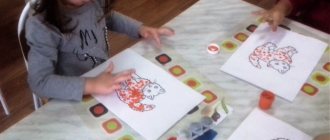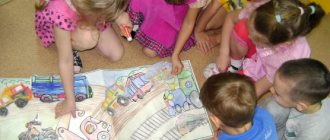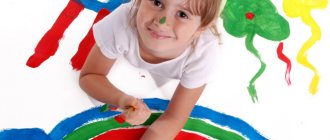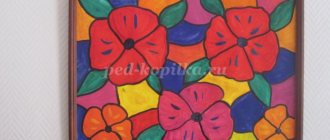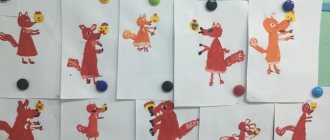Planning drawing lessons on the topic “Transport”
In the senior group, standard long-term planning provides for one drawing lesson per week. The total duration of continuous activity should not exceed 20–25 minutes. Methodological manuals recommend performing physical exercises (finger, breathing, motor exercises) for 5 minutes for relaxation and prevention of mental and physical fatigue in children.
Lesson outline:
- Organizational part - includes an educational or playful conversation of a motivating nature, which is accompanied by demonstration of visual material, reading poems and riddles, listening to a fragment of a musical or literary work, stimulating the activity of children and setting them up to work with a specific subject image (approximately 3-5 minutes).
- Practical part - the teacher explains the sequence of drawing parts after examining the object (3-5 minutes). Older preschoolers are given more freedom in the drawing process; the sample is used, as a rule, only in decorative drawing. A picture or sample prepared by the teacher should not be used for copying, but only to form a correct understanding of the task or clarify it. The work is done from life or on the basis of life experience and observation; the basic techniques have already been mastered, and therefore do not require additional demonstration, with the exception of the initial use of new material, for example, sanguine.
- Independent work of children (15–20 minutes).
Setting up a demonstration stand will help children imagine their future work. - The final part - a comparison of children's images with the object is made, the degree of similarity between the original and the artistic copy is assessed (3 minutes).
Table: didactic games for classes on the topic “Bus” (“Urban transport on our street”, author E. R. Fedotova)
| A game | Content |
| "The Fourth Wheel" | The teacher asks the children to identify the extra word in the series and explain why it is extra. - Tram, bus, plane, trolleybus. (The word “plane” is superfluous, because this is an air mode of transport, and the rest are land-based) - Boat, helicopter, cutter, liner. (The word “helicopter” is superfluous, because this is an air mode of transport, and the rest are water-based) - Yacht, steamship, fire engine, ship (The word “fire engine” is superfluous, because this is a special transport, and the rest are water-based) |
| "Fix the problem" | — We ended up in a repair shop. There are a lot of broken vehicles here! Do you want to renovate? (Children complete the pictures of transport with the missing parts, then make up a sentence about what they did: “I repaired the bus,” similarly for the rest) |
| Dynamic pause “Traffic signals” | The teacher shows the children colored paper circles. If the circle is red, the children squat; if the circle is yellow, they stand up; if the circle is green, they walk in place. |
| "Ride the Bus" | Educator: Guys, a bus is waiting for us at the stop, but for it to go, we need a driver. Now we will choose a driver according to the counting rhyme. - We're going to play, well, who should start? One, two, three, you begin. — What does a driver need to drive a bus? (children's answers). - Get behind the wheel, driver, and take the passengers. — What are the names of the people who travel on the bus? (Passengers) Educator: Who should be allowed through when entering the bus? (Children's answers.) Please, passengers, take your seats. - Who else is on the bus? (Children's answers.) - When passengers ride on a bus, the conductor sells tickets. I will be the conductor (the teacher has a conductor’s bag). We have a magic bus in which tickets are issued for polite words (the conductor issues tickets for polite words). |
| "It is possible - it is not possible" | — Let's remember the rules of conduct for passengers on public transport. Answer whether it is possible or not:
|
| Finger gymnastics “Transport” | (As we read the poem, we bend our fingers one by one) The first finger, the baby, and I will go to the tram park on foot. With the other, we will go on a tram, quietly humming songs. The third and I will get into a taxi and ask them to take us to the port! With the fourth finger in the rocket We will fly to another planet. Come on, number five, get on the plane, we’ll go flying with you. Conductor: Passengers, be careful, the bus is approaching the stop, get ready to get off. — How should you get off the bus? (children's answers). What should you do with your tickets after traveling on the bus? (Children throw tickets into the trash can next to the bus stop) Educator: Guys, there is a pedestrian crossing in front of us. Take your time, look left, right. Let's calmly walk through the pedestrian crossing. (Children walk along the pedestrian crossing). |
Photo gallery: demonstration material for a lesson on the topic “Bus”
The didactic game “Name it Correctly” helps develop thinking
Didactic game "The Fourth Odd" trains logic
Sidewalk rules can be explained in a playful way
Rules for crossing the road - the basis of traffic rules for children
Table: summary of a lesson in drawing with colored pencils on the topic “Bus decorated with flags” (author V. G. Bozhko)
| Topic: “Bus decorated with flags” | |
| Tasks |
|
| Handout |
|
| Organizational part | - Now I will show you pictures of transport, and you will say the name of this transport. (We show and the children name). Well done. Now let's remember the types of transport. What type of transport is a ship? (Water). - Why? (Because he floats on water). - Well done. Bus, tram and trolleybus - what type of transport is this? (Terrestrial because it moves on the ground). - Fine. What type of transport is an airplane and a helicopter? (Aerial because they fly through the air). - Right. Today we will draw a representative of the ground class - a bus. I brought you a bus today, let’s look at it and touch it. Name the main parts of the bus. (Wheels, windows, doors, headlights). - Fine. Why does a bus need windows? (So that people can see where they are going). — Why does the bus need doors? (To board and disembark passengers at stops). - That's right, why does it need wheels? (To move along the road). — Why do the bus have headlights? (So he can ride in the dark). - Well done, we will mark these main parts of the bus in our drawing using pencils. |
| Practical part | - And now you guys and I will learn to draw a bus. - Let's look at the sample that I prepared for you. Look at the blackboard. (We post a sample of the work). Look how I have drawn all the main parts of the bus step by step. At the end of the work, we will decorate our buses with flags and balloons. - Let's get to work. |
| Independent work of children | Children draw. |
| Physical school | We're sitting on the bus. We look out of the window. Look left, look right. Don't miss anything. Stop. Come out. And look outside. Walk boldly, without anxiety - There is no safer road. Do you guys remember everything? And isn’t it a little scary to walk? Well, let's check, we'll see, But first we'll repeat: Before counting and writing, Drawing, reading, All the kids need to know...? (Rules of movement) - And now, for the sake of order, you guess the riddle - Stop! - says his order. The yellow eye looks at us: - Be careful! Stop now! And green: well, go ahead, Pedestrian, to the crossing! |
| Final part. | — We are finishing our work. Place all the finished drawings on the table, examine them, select more interesting works, and invite the children to talk about them. Praise the guys for completing the task. |
Drawings prepared by children can be shown to parents
On the topic: methodological developments, presentations and notes
Summary of integrated activities on artistic creativity in the senior group Topic: “A bus decorated with flags rides down the street.”
Open drawing lesson for the senior group.
Summary of integrated artistic creativity activities in the senior group with application elements. Theme: “A bus decorated with flags drives down the street.” .
Goal: to teach children to depict certain types of transport, to convey the shape of the main parts, details, their size and location; learn to beautifully place an image on a sheet of paper, draw large; fasten .
Goal: to teach children to depict certain types of transport, to convey the shape of the main parts, details, their size and location; learn to beautifully place an image on a sheet of paper, draw large; fasten .
Notes on artistic and aesthetic development (drawing) on the topic: “A bus decorated with flags.” (senior group).
Source
Preparatory stage of the lesson
In the older group, children improve the drawing skills that they previously mastered. The guys combine simple geometric shapes in one composition, detailing the appearance of the transport. So, the drawing of a bus is “assembled” by drawing circles for the wheels, a rectangle for the body and squares for the windows. Then the children show the outlines of the doors, decorate the vehicle with a logo or advertising inscription, figures of passengers, and think over the background for the image. They also create a composition by adding a pedestrian crossing, a traffic light, etc. The emphasis is on the correct location of near and far objects: the closer, the larger the image. In addition, the issues of correct image of parts: windshield wipers, distant mirrors, etc. remain relevant.
In the drawing of a bus, children of the older group pay special attention to the depiction of transport details
Basis and tools for creating a drawing
The bus is usually depicted on A4 sheets in horizontal orientation. If the drawing is planned as a group drawing, for example, “Buses on the streets of our city,” then you can use whatman paper as a basis. To create pictures in pairs, it is more convenient to use the A3 format. Pupils of the senior group depict the bus not by itself, but in the plot, which requires advance preparation of the substrate. To do this, the sheet is partially tinted, for example, to show the sky, then the roadway and houses in the background are drawn. Tinting is usually done by a teacher; children can help in mixing paint with water, as well as in distributing the tone within the boundaries of the depicted element, in our example, the sky.
Preview:
Summary of integrated activities in artistic creativity in the senior group
Theme: A bus decorated with flags is driving down the street.
Preliminary work: observing different types of transport while walking, looking at illustrations on the topic “Transport”, didactic games “Red, Yellow, Green”, “Rules and Road Safety”, guessing riddles on the topic.
Equipment: ball, pictures of a bus and other types of transport, sky, water, road; A4 sheets, colored pencils, a simple pencil and an eraser - for each child.
Methods and techniques: surprise moment, demonstration of actions, questions to children, didactic game, looking at illustrations,
The teacher drives one or two cars and asks the children:
- Guys, what am I playing now? (cars, bus)
- What is transport used for? (for transportation of goods and passengers)
In primitive times, when people lived in caves, there was no transport, people moved on foot. Then they tamed the horse and began to move from place to place on horseback. But they still needed to transport things, and then people invented the wheel and made a cart. This is how the first transport appeared.
- What is the name of the transport that transports goods? (cargo)
— what kind of cargo can be transported with its help? (bricks, vegetables)
- What is the name of the transport that transports people? (passenger)
— what types of transport are there? (showing pictures of the sky, river (sea), road). (Children's answers: ground, underground, air, water).
Children play the game “Types of Transport”, throw a ball to each other in a circle and name the different vehicles, who caught the ball, names what type of transport the named vehicle is.
Educator: Now I suggest you draw your bus and decorate it with flags so that the passengers on it will be happy and everyone will be in a good mood when arriving at their destination.
Look at the picture. What shape is the bus? What size? Name the parts of the bus.
Educator: what did we talk about today, what did we draw? What is transport needed for? What were you interested in doing? What else do you want to know about transport? We will definitely talk about this with you.
Well done, everyone did a good job today, drew, and you can play!
Source
Preview:
Summary of integrated activities in artistic creativity in the senior group
Theme: A bus decorated with flags is driving down the street.
Preliminary work: observing different types of transport while walking, looking at illustrations on the topic “Transport”, didactic games “Red, Yellow, Green”, “Rules and Road Safety”, guessing riddles on the topic.
Equipment: ball, pictures of a bus and other types of transport, sky, water, road; A4 sheets, colored pencils, a simple pencil and an eraser - for each child.
Methods and techniques: surprise moment, demonstration of actions, questions to children, didactic game, looking at illustrations,
The teacher drives one or two cars and asks the children:
- Guys, what am I playing now? (cars, bus)
- What is transport used for? (for transportation of goods and passengers)
In primitive times, when people lived in caves, there was no transport, people moved on foot. Then they tamed the horse and began to move from place to place on horseback. But they still needed to transport things, and then people invented the wheel and made a cart. This is how the first transport appeared.
- What is the name of the transport that transports goods? (cargo)
— what kind of cargo can be transported with its help? (bricks, vegetables)
- What is the name of the transport that transports people? (passenger)
— what types of transport are there? (showing pictures of the sky, river (sea), road). (Children's answers: ground, underground, air, water).
Children play the game “Types of Transport”, throw a ball to each other in a circle and name the different vehicles, who caught the ball, names what type of transport the named vehicle is.
Educator: Now I suggest you draw your bus and decorate it with flags so that the passengers on it will be happy and everyone will be in a good mood when arriving at their destination.
Look at the picture. What shape is the bus? What size? Name the parts of the bus.
Educator: what did we talk about today, what did we draw? What is transport needed for? What were you interested in doing? What else do you want to know about transport? We will definitely talk about this with you.
Well done, everyone did a good job today, drew, and you can play!
Preview:
Summary of integrated activities in artistic creativity in the senior group
Theme: A bus decorated with flags is driving down the street.
Preliminary work: observing different types of transport while walking, looking at illustrations on the topic “Transport”, didactic games “Red, Yellow, Green”, “Rules and Road Safety”, guessing riddles on the topic.
Equipment: ball, pictures of a bus and other types of transport, sky, water, road; A4 sheets, colored pencils, a simple pencil and an eraser - for each child.
Methods and techniques: surprise moment, demonstration of actions, questions to children, didactic game, looking at illustrations,
The teacher drives one or two cars and asks the children:

